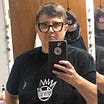I Was FG. But No One Put Me on Blockers.
What The New York Times left out about the first child on puberty blockers—and what it means for the rest of us who made it through
When I listened to the first episode of “The Protocol,” I didn’t hear a story of medical innovation. I heard a story about a girl I could’ve been—if the adults around me had read my discomfort as disease. FG, the first minor ever to be put on puberty blockers to treat anything other than precocious puberty, was twelve years old when doctors decided her gender nonconformity needed to be stopped in its tracks. Not because she was suicidal. Not because she hated herself. Not because she was asking to transition. But because she didn’t want to grow into a woman.
Neither did I.

I cut my hair short when I was six and didn’t wear it long again until I was in my twenties. I was mistaken for a boy constantly. I didn’t wear dresses. I took kung fu. I avoided the locker room by signing up for band instead of PE. I didn’t want to be seen as weak, didn’t want to be called “girlie,” didn’t want breasts or hips or softness. I wasn’t confused about my sex—I just didn’t want what the world did to girls like me. But no one told me I was trans. No one put me on blockers. And because of that, I’m still here—an adult woman, a lesbian, someone who grew through it instead of being frozen in place.
FG never got that chance.
The podcast series paints the Dutch as paragons of caution, as if they were meticulous gatekeepers whose careful protocol was bastardized by reckless Americans. But that’s a myth. The Dutch were never pure in their approach. FG’s first experimenter, Henriëtte Delemarre-Van de Waal, who had only ever treated precocious puberty before, asked the powers that be to lower the minimum age for blockers from 18 to 16 on FG’s behalf. When FG, at just 12, was told she’d still have to wait, she demanded to start right away. And the adults—those supposedly careful Dutch doctors—caved to a child’s insistence. They broke their own rules from the very start, setting a precedent for child-led experimentation on children.
She says she had a happy childhood. The problems didn’t start until puberty. That’s when everything felt wrong—when her body started betraying the tomboy self she felt comfortable in. She didn’t want to become what her conservative father expected of a daughter. She didn’t want the attention that came with a developing female body. At twelve, she wrote a dramatic poem—angsty, expressive, the kind of thing a lot of teens write when they’re overwhelmed and don’t yet have the tools to cope. But the doctors latched onto that as evidence of suicidality. Even FG, in hindsight, discredits that interpretation. It wasn’t a suicide note. It was a poem. But it was enough for them to initiate a medical experiment with a child at its center.
FG was the guinea pig, and she didn’t even know it. Neither did her parents. The doctors didn’t tell them this had never been done before. They didn’t say they were entering uncharted territory. They didn’t say “we’re about to block your daughter’s natural puberty to see if it makes her feel more like a boy.” They said she would be the first to benefit from a compassionate new protocol. Then they lied again later—saying she’d grown up to become a doctor herself, just to protect the image of their “success story.” This isn’t medicine. This is manipulation. And if there were ever a moment to bring in a medical ethicist to reflect on what it means to suppress a child’s development for years based on weak evidence and social discomfort, this podcast had it. But “The Protocol” doesn’t take that step. The New York Times didn’t even try for objectivity. No ethicists. No psychologists with dissenting views. No lesbian adults who could’ve offered a different path.
The podcast points fingers at Americans for going rogue, but even Laura Edwards-Leeper, portrayed as the careful importer of the Dutch Protocol to the U.S., changed the rules as soon as she started. She loosened the criteria, widened the net, and suddenly more kids were being fast-tracked onto blockers without the rigorous psychological assessments the Dutch supposedly championed. The Dutch, meanwhile, had already shown their protocol was flexible to the point of fragility—bending to a twelve-year-old’s demands and keeping her in stasis far beyond any reasonable limit.
By 16, FG still hadn’t resumed puberty. She was offered the chance to start testosterone—but she was allowed by Peggy Cohen-Kettenis to decline. Not because she was unsure, but because she didn’t want to transition in front of her peers. She didn’t want to have to explain herself. And that was apparently enough to justify keeping her frozen in place. She stayed on blockers until eighteen. Six years. Six years without the hormonal cascade that governs not just sexual development, but brain maturation, bone growth, emotional regulation, and basic social adaptation. That’s not a “pause.” That’s arrest.
Then, just before college, she took a year off, started testosterone, and began life “as a man.” The podcast frames this as a quiet triumph. But I heard something else. I heard emotional fragility. I heard developmental delay. I heard someone still watching herself through the eyes of others, fixated on how she’s perceived. FG talks constantly about her size, her stature, her desire to pass. But no one at The Times ever raises the possibility that being on puberty blockers from 12 to 18 might have stunted her growth. Instead, they treat it like a personality trait—something to overcome with more time, more silence, more testosterone.
FG doesn’t tell people she’s trans. She calls that a “hang-up.” But to me, it sounds like shame. She doesn’t sound liberated. She sounds hidden. Burdened by the need to pass, to blend in, to never be found out. That’s not joy. That’s survival through suppression.
I understand that impulse. I remember wanting to disappear during puberty too. I remember panic attacks. I remember trying to take my own life at fourteen. But no one gave me drugs to disappear. No one froze my body and told me to restart later when it was more convenient. And for that, I am endlessly grateful. Because I lived long enough to realize I wasn’t trans. I was lesbian. I was a gender-nonconforming girl trying to exist in a world that didn’t know what to do with girls like me.
FG’s story is not a success. It’s a case study in institutional failure—medical, ethical, emotional. The Times treats it as the beginning of “how we got here,” but they frame it as if the path was obvious, inevitable, and safe. It wasn’t. The Dutch started by breaking their own rules, caving to a child’s demands and keeping her in limbo for years. Americans like Edwards-Leeper followed suit, widening the experiment without questioning its foundation. A twelve-year-old girl was shut down physically and emotionally, kept in stasis until she could disappear and re-emerge as someone unrecognizable. And we’re all supposed to clap because she passes.
I was FG—but I was spared. And because of that, I’m still here, with a full-sized body, a fully developed mind, and a voice that says what FG still can’t: we were never broken. We were just girls who didn’t fit.
And no amount of drugs will ever justify erasing us.







And a lot of “transing” these kids has nothing to do with the poor kids but to affirm a nonsense ideology for grown, fetishisistic cross dressing men.
I’m happy for you and sad for all the kids who have gone through the “care” that trans activists are pushing. We are doing what we can to keep our 18year old away from this insanity but he is sooo convinced it will be the answer to all his problems.